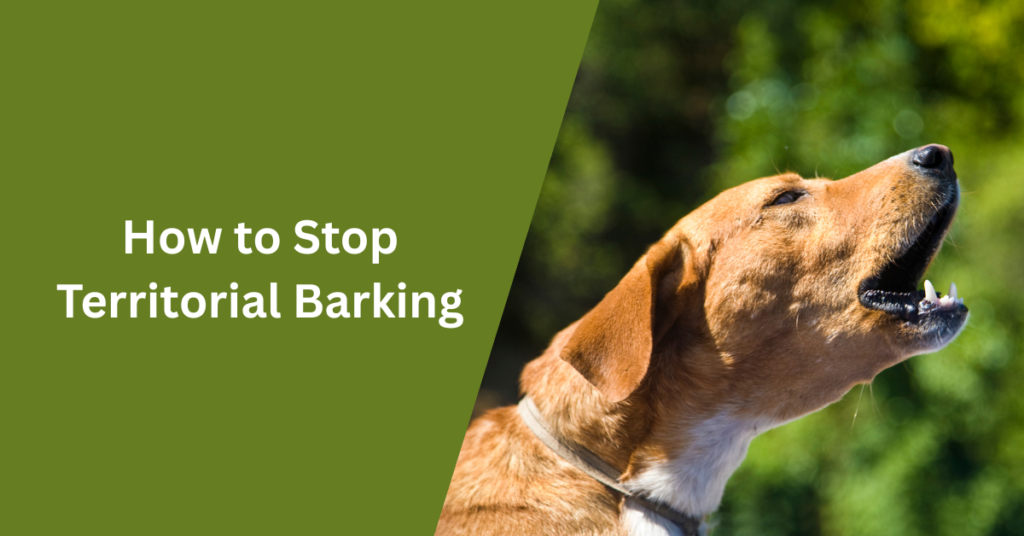Stop territorial barking by blocking triggers, teaching quiet commands, and reinforcing calm behavior. Close blinds or use barriers to limit your dog’s view, redirect barking with “quiet” followed by a reward, and reward only when silence is maintained. Daily exercise, mental stimulation, and consistent training reduce territorial stress and keep barking under control.
Common situations that spark territorial barking
Several situations consistently trigger territorial responses:
- Mail carriers delivering packages
- People or animals passing by windows
- Visitors approaching the door
- Maintenance workers near the property
- Vehicle sounds near the home
- Family members leaving while the dog stays inside
Physical barriers often intensify territorial behavior. Dogs prevented from directly accessing perceived threats by fences, doors, or leashes may display heightened territorial responses.
How dogs perceive threats to their space
Dogs evaluate potential threats through multiple sensory channels. Their exceptional sense of smell, estimated to be 10,000 to 100,000 times more sensitive than humans, allows them to detect subtle changes in a person’s scent that might indicate anxiety or agitation.
Dogs also closely observe body language cues that humans unknowingly display. Stiff movements, direct eye contact, and nervous smiling can mimic aggressive displays in canine body language. Standing tall over a dog or making direct eye contact may be interpreted as threatening behavior, particularly during first encounters.
Setting Up Your Training Environment
Success in territorial bark training begins with creating an environment that sets both you and your dog up for positive results. By carefully managing the training space and gathering essential tools, you’ll establish a foundation for effective learning.
Creating a calm training space
First, ensure your dog receives adequate exercise before starting any training session. A tired dog responds better to training commands and shows improved focus. Moreover, physical activity helps reduce built-up energy that often manifests as excessive barking.
To create a serene atmosphere, consider incorporating these elements:
- Classical music or white noise machines to mask outside sounds
- Soothing background music, especially harp or classical compositions, which studies show promotes relaxed behavior in dogs
- A designated quiet area where your dog feels secure and comfortable
Essential training tools and treats
Preparing the right tools significantly impacts training effectiveness:
- High-value treats, preferably freeze-dried varieties that maintain freshness throughout training sessions
- Interactive puzzle toys and stuffed Kongs to keep your dog mentally engaged
- A treat storage system positioned away from training triggers to create distance control
- Clicker or marker device for precise timing in reward-based training
Consider storing treats in strategic locations throughout your home. Placing treat containers opposite to trigger areas, like windows or doors, encourages your dog to move away from potential barking spots.
Removing visual triggers temporarily
Until your dog develops better control over territorial responses, managing their environment becomes crucial. Consider these proven methods:
- Window Management:
- Install decorative window film that allows light while blocking outside views
- Apply bubble wrap as a temporary DIY solution – spray water on windows and attach with the flat side down
- Close blinds or curtains during peak activity times outside
- Space Organization:
- Rearrange furniture to prevent access to window-watching spots
- Use baby gates to block access to high-trigger areas
- Create a long-term confinement area away from street-facing windows
For apartment dwellers facing unique challenges, sound management becomes especially important. The proximity of neighbors and constant hallway activity requires additional consideration. Installing white noise machines or fans near entry points helps muffle potential trigger sounds.
Basic Commands for Bark Control
Teaching your dog basic commands forms the cornerstone of controlling territorial barking. By mastering these fundamental cues, you’ll establish clear communication channels with your furry friend, making it easier to redirect unwanted barking behaviors.
Teaching the ‘quiet’ command
The ‘quiet’ command helps interrupt barking episodes effectively. Start by waiting for your dog to bark naturally, then follow these steps:
- Wait approximately 10 seconds for the barking to subside slightly
- Place a high-value treat directly in front of their nose immediately after they pause
- Say “quiet” in a conversational, friendly tone
- Reward them when they stop barking to sniff or eat the treat
As your dog progresses, gradually extend the duration between the command and reward. Begin with one second of silence, steadily increasing the quiet period. Remember that dogs cannot bark while sniffing or eating, making these activities invaluable tools for training.
Using ‘place’ or ‘go to bed’ commands
The ‘place’ command proves remarkably versatile in managing territorial behavior. This command instructs your dog to go to a designated spot and remain there until released. The beauty of this command lies in its adaptability – it works equally well at home, outdoors, or in public spaces.
To implement the ‘place’ command effectively:
- Start with a clearly defined boundary, like a dog bed or mat
- Begin training in low-distraction areas
- Teach a release cue first, ensuring your dog understands when they can leave their spot
- Gradually introduce the command in different locations
- Use a long leash initially to ensure success
Progressive Desensitization Steps
Desensitization stands as a proven method for addressing territorial barking through systematic exposure to triggers. This science-backed approach gradually helps your dog build positive associations with previously challenging situations.
Starting with mild triggers
Begin desensitization by identifying your dog’s reaction threshold – the distance at which they first notice a trigger without becoming overly reactive. Record common trigger sounds, like doorbells or delivery vehicles, and play them at very low volumes. Throughout this process:
- Start with the trigger at a distance where your dog remains calm
- Pair each exposure with high-value treats
- Stop rewards immediately when the trigger disappears
- Create positive associations consistently
For sound-sensitive dogs, consider implementing a structured noise desensitization protocol. Playing urban walking videos or controlled recordings helps acclimate your dog to everyday sounds in a safe environment.
Maintaining distance control
Distance management forms a crucial component of successful desensitization. Proper distance control requires:
- Clear hand signals visible from afar
- Consistent directional commands
- Body language that reinforces your instructions
- Regular practice in various environments
Think of distance control like a clock face when giving directional commands. This mental image helps maintain consistency in your signals, preventing confusion for your dog during training sessions.
Reward-Based Training Techniques
Effective reward-based training relies heavily on precise timing and selecting the right incentives. Understanding these elements transforms territorial barking into an opportunity for positive reinforcement training.
Timing your rewards correctly
Precise timing marks the difference between reinforcing desired behavior versus accidentally rewarding unwanted actions. Consider these fundamental principles:
- Mark the exact moment your dog stops barking
- Deliver treats within one second of quiet behavior
- Maintain consistency in reward timing across training sessions
As your dog progresses, gradually extend the duration between silence and rewards. Begin with immediate reinforcement, steadily working up to five seconds of quiet before offering praise and treats. This systematic approach strengthens your dog’s understanding of the desired behavior.
Choosing effective treats
Selecting appropriate treats significantly impacts training success. Small, soft treats prove most effective because they allow quick consumption and immediate return to training. Consider these characteristics when choosing training rewards:
- Size matters:
- Use pea-sized portions for large dogs
- Opt for even smaller pieces for small breeds
- Cut larger treats into tiny bits before sessions
- Texture considerations:
- Soft treats enable faster consumption
- Avoid crumbly biscuits that create cleanup distractions
- Select treats that don’t require extensive chewing
Food rewards work most effectively alongside a structured training approach. Establish a clear hierarchy of treats based on their value to your dog. Reserve premium treats – typically those with strong aromas like cheese or freeze-dried meat – for challenging situations or breakthrough moments.
Managing Different Barking Scenarios
Territorial barking presents unique challenges in different scenarios. By tailoring our approach to specific situations, we can effectively address this behavior and create a more harmonious living environment for both dogs and their owners.
Door visitor protocol
Doorbell rings and knocks often trigger intense territorial responses in dogs. To manage this behavior, we need a structured approach:
- Establish a designated spot: Choose a place away from the door where your dog can comfortably settle. This could be a bed, mat, or crate.
- Practice the ‘place’ command: Train your dog to go to their spot on cue. Start in low-distraction environments and gradually increase difficulty.
- Simulate door visits: Enlist a friend’s help to practice controlled scenarios. Begin with mild triggers like gentle knocks and progress to more intense stimuli.
- Reward calm behavior: Use high-value treats to reinforce quiet, settled responses. Timing is crucial – reward the moment your dog shows composure.
- Implement a visitor routine: When guests arrive, direct your dog to their spot before opening the door. Reward compliance and maintain the ‘place’ command until your dog is calm.
For persistent barkers, consider using a “Thank you” cue instead of harsh corrections. This approach acknowledges your dog’s alert while redirecting their focus. If barking continues, calmly guide your dog to a separate room until they settle.
Window watching behavior
Many dogs spend hours monitoring the outside world through windows, often resulting in excessive barking. To address this issue:
- Manage the environment: Use window film, curtains, or blinds to block your dog’s view of potential triggers. This simple step can significantly reduce reactive behavior.
- Create alternative activities: Provide engaging toys and puzzles to redirect your dog’s attention away from windows. Rotate these items regularly to maintain interest.
- Establish ‘quiet zones’: Use baby gates or furniture arrangement to limit access to prime window-watching spots. This prevents your dog from practicing unwanted behaviors.
- Implement the ‘leave it’ command: Teach your dog to disengage from window stimuli on cue. Start with mild distractions and gradually increase difficulty.
- Reward calm observation: When your dog watches out the window without barking, offer praise and treats. This reinforces quiet vigilance over reactive behavior.
For apartment dwellers facing unique challenges, consider using white noise machines or fans to mask external sounds that might trigger barking. This creates a more controlled auditory environment for your dog.
Yard boundary training
Maintaining control over your dog’s behavior in outdoor spaces is crucial for preventing territorial barking. Follow these steps to establish clear boundaries:
- Define the perimeter: Use visual markers like flags or stakes to outline your yard’s boundaries. This provides a clear reference point for both you and your dog.
- Start with on-leash training: Walk your dog around the perimeter, rewarding them for staying within bounds. Use a long lead (15-20 feet) for greater freedom of movement.
- Introduce the boundary cue: Choose a specific word or phrase like “Edge” or “Boundary” to signal the yard’s limits. Use this cue consistently during training sessions.
- Practice recall from the boundary: Call your dog away from the edge, rewarding them generously for returning to you. This reinforces the idea that staying within bounds is more rewarding than exploring beyond.
- Gradually increase distractions: Introduce controlled stimuli like people walking by or neighbors working in their yards. Reward your dog for maintaining focus and staying within boundaries.
- Transition to off-leash training: Once your dog demonstrates consistent boundary awareness, begin practicing without the leash. Supervise closely and be prepared to reinforce rules if needed.
Conclusion
Territorial barking presents a common challenge for dog parents, though consistent training and patience yield remarkable results. Through proper understanding of triggers, environmental management, and positive reinforcement techniques, any dog can learn appropriate barking behavior.
Success depends on following a structured approach – starting with basic commands, progressing through desensitization exercises, and applying specific strategies for different scenarios. Most importantly, remember that each dog learns at their own pace, therefore adjusting training methods based on your pet’s responses ensures lasting behavioral changes.
The combination of proper setup, consistent practice, and positive reinforcement creates a foundation for transforming territorial behavior. Rather than viewing barking as problematic, consider it an opportunity to strengthen your bond while teaching your dog appropriate ways to alert and respond to their environment.
I’ve loved dogs all my life and have cared for many different breeds over the years. Here, I share simple tips, stories, and helpful advice for all dog lovers. Whether you’re a new pet parent or a lifelong dog fan, you’ll find something useful and fun on my site.


